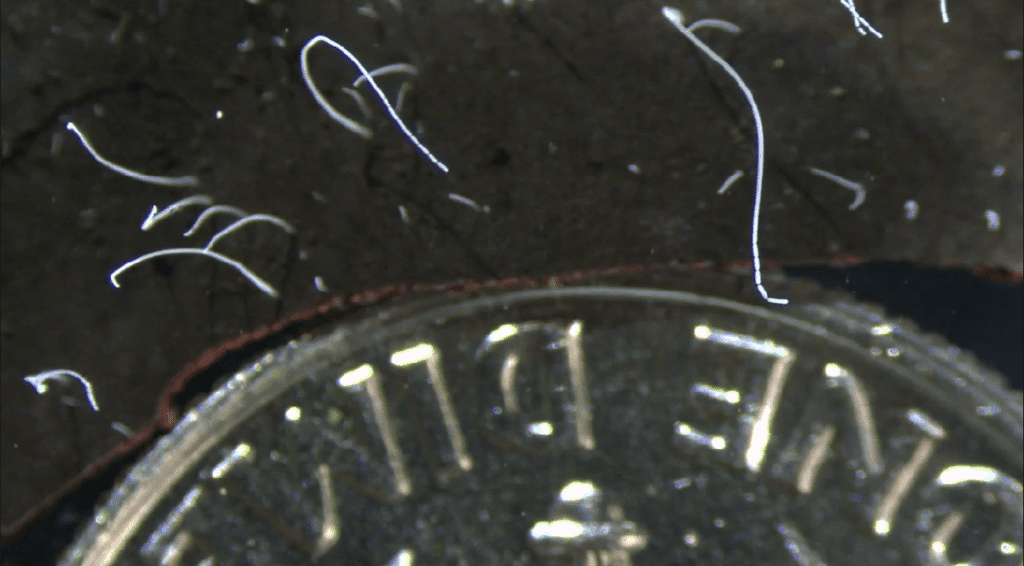
Until Antoni van Leeuwenhoek first discovered bacteria in 1676, we didn’t even have a name for these tiny microbes. Viruses, which are an order of magnitude smaller than bacteria and require even more powerful microscopes to observe, weren’t discovered until 1892 when Dmitry Ivanovsky isolated the tobacco mosaic virus. Imagine everyone’s surprise when scientists recently discovered a bacterium so large it’s visible to the naked eye.
This giant string-like bacterium, native to the Caribbean mangroves, can grow up to 2 centimeters in length, about the size of a fly. It’s about 5,000 times larger than most other microbes, stretching the limits of what we thought biologically possible for a single-celled organism.
Christened Thiomargarita magnifica by an international team of researchers, which included scientists from the Lawrence Berkeley National Laboratory in the US and the CNRS in France, the newly discovered organism dwarfs other so-called “giant bacteria” by about 50-fold.
“All too often, bacteria are thought of as small, simple, ‘unevolved’ life forms—so-called ‘bags of proteins,’” Chris Greening, a microbiologist at Monash University, Clayton, who was not involved in the study,” told Science. “But this bacterium shows this couldn’t be much further from the truth.”
The secret to T. magnifica‘s chunky size may lie in the arrangement of its genetic material, which is atypical. Bacteria and other single-cell microbes called archaea are classed as prokaryotes, while multicellular organisms like trees and humans are classed as eukaryotes. One of the defining differences between the two is that prokaryotes have free-floating DNA, while eukaryotes package their genetic code in a nucleus.
However, T. magnifica is blurring the lines between eukaryotes and prokaryotes because its huge genome is not free-floating inside its cell as in other bacteria. Instead, it’s encased in a membrane. When researchers sequenced the genome, they were amazed by its size: 11 million bases that line up to form 11,000 genes. For comparison, your run-of-the-mill bacterium only has about 4 million bases and about 3,900 genes.
“Importantly, we show that centimeter-long Thiomargarita filaments represent individual cells with genetic material and ribosomes compartmentalized into a novel type of membrane-bound organelle. Sequencing and analysis of genomes from five single cells revealed insights into distinct cell division and cell elongation mechanisms,” the researchers wrote in a paper that appeared in the preprint server bioRxiv. The findings haven’t been peer-reviewed yet.
These extraordinary findings suggest that the two major branches of life aren’t all that different after all — and T. magnifica could be a missing link that explains how complex life evolved from the most primitive single-celled organisms more than a billion years ago.
The giant bacterium’s DNA is encased in a sac embedded in its membrane. It has another much larger membrane sac that is filled with water and takes up 73% of the microbe’s volume. This external sac allows the organism to grow so large while keeping its essential organelles packed in a small space to facilitate the diffusion of molecules in and out of the microbe.
“These unique cellular features likely allow the organism to grow to an unusually large size and circumvent some of the biophysical and bioenergetic limitations on growth,” said the researchers, who have compared T. magnifica to other microbes called Large Sulfur Bacteria, which form very long filaments that may reach several centimeters in length. However, unlike T. magnifica, these sulfur bacteria are composed of thousands of individual cells, each no larger than 200 micrometers.
The origin of complex life is one of the most important, yet unanswered, questions in biology. Most bacteria are tiny and dull, but some are complex and feature innovative biological machinery. T. magnifica is a prime example of the latter, with its large genome, gigantic cell size, and unheard-of compartmentalization of genetic material in its membrane.
“T. magnifica adds to the list of bacteria that have evolved a higher level of complexity. It is the first and only bacteria known to date to unambiguously segregate their genetic material in membrane-bound organelles in the manner of eukaryotes and therefore challenges our concept of a bacterial cell,” the researchers wrote.
This story originally appeared in February 2022 and was updated with new information.






